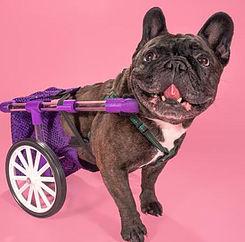
Jim Song is one of those people. He’s familiar with the work done by e-NABLE, which has amassed a community of thousands of makers dedicated to designing, redesigning, improving, and building 3D printed prosthetics to be delivered to kids with missing hands and arms all over the world. He’s also a friend of Prashant Gade, creator of the 3D printed Bio_Nick prosthetic arm. With his knowledge of 3D printing and prosthetic devices, Song decided to start his own service: the Computer Aided Pets (CAP) Project, which he describes as a sort of e-NABLE for pets.
The CAP Project is brand new; Song just got the website up and running a few days ago, but he’s already gotten interest from several owners of disabled pets. The project works just like e-NABLE: caretakers of animals in need of a prosthetic or assistive device contact the organization, and CAP will pair them with a volunteer, preferably in the same geographic location. That volunteer will then work with the animal and its caretaker to design and fit a prosthetic for it.
Also like e-NABLE, the CAP Project is building a database of 3D prosthetic designs that can be downloaded and modified to fit the needs of a particular animal. Designs submitted thus far include a wheelchair for dogs, cats or other animals missing their front legs; a wheelchair for animals missing their back legs; a forelimb prosthesis for a four-legged animal; a prosthetic eagle foot; and a stork leg.
“We all can make a difference. It doesn’t matter who you are all it takes is for one person to do a good deed and than you have a movement,” Song told 3DPrint.com. “The volunteers are the real heroes and deserve the recognition…this project was the product of a ton of amazing people’s work and dedication and no words can express that.”
Since the CAP Project is so new, volunteers are desperately needed to help meet the requests that are already coming in. To apply to be a volunteer, start your own chapter, or request a prosthetic for your pet, click here. Don’t have a 3D printer or design skills, but still want to help? Volunteers are also needed to act as managers and moderators for the website and social media platforms. The CAP Project may be just getting started, but it didn’t take e-NABLE long to grow from one person to a community of thousands. I hope the CAP Project takes off in the same way. Discuss further over in the 3D Printed Prosthetics for Dogs forum at 3DPB.com.